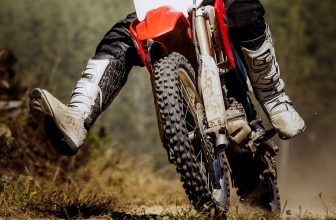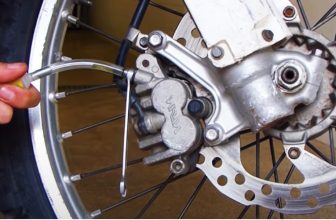How to Bleed Front Brakes on Dirt Bike
Maintaining your dirt bike is essential to keeping it running in top condition. One of the most important maintenance tasks is bleeding the front brakes. When you’re out on the trails, there’s nothing more important than having functioning brakes.
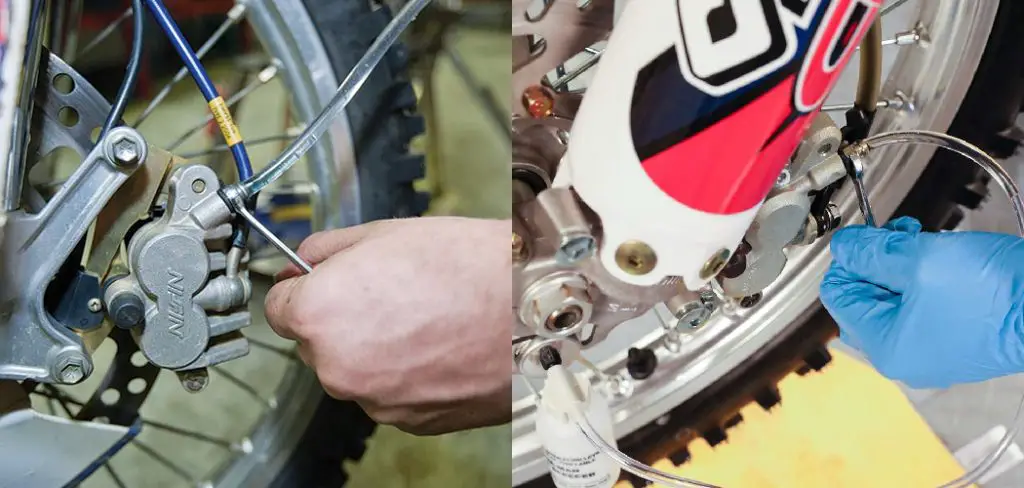
This post will show you how to bleed front brakes on dirt bike. This essential maintenance procedure should be performed regularly to keep your bike stopping safely. So whether you’re a beginner or an experienced rider, follow these steps to bleed your front brakes properly. Read on for more information.
How to Bleed Front Brakes on Dirt Bike in 10 Easy Steps
Step 1: Get the Right Tools.
To bleed your front brakes, you’ll need a few tools. You’ll need a syringe, brake fluid, and a Phillips head screwdriver. Make sure all the tools you use are clean and in good condition. When Using the syringe, be careful not to introduce any air into the system.
Step 2: Remove the Brake Pads.
Start by removing the brake pads. This can be done by unscrewing the retaining screws and pulling the pads away from the Caliper. Once the pads are removed, press on the caliper piston to push it back into the housing. Always keep an eye on the brake fluid level in the reservoir while doing this.
Step 3: Prep the Brake Fluid.
Open up the container of brake fluid and pour it into the syringe. Be sure to use fresh fluid that’s within its expiration date. Old or contaminated fluid can damage your brakes and cause expensive repairs. If you think the fluid might be old, err on caution and get new fluid. Next, attach the syringe to the bleed screw on the Caliper. If your bike has more than one brake caliper, repeat this process for each Caliper.
Step 4: Loosen the Bleed Screw.
With the syringe attached to the bleed screw, loosen the screw until fluid starts to drip out. Be careful not to loosen the screw too much or it will fall out, and you’ll have to start over. When losing the bleed screw, ensure you don’t get any air in the syringe.
Step 5: Pump the Brake Lever.
With the bleed screw open, pump the brake lever until you see fluid coming out of the syringe. Be sure to check the level of fluid in the master cylinder regularly so it doesn’t run dry. If air bubbles appear in the fluid, close the bleed screw and start over. Getting rid of all the air in the system is important for proper braking performance.
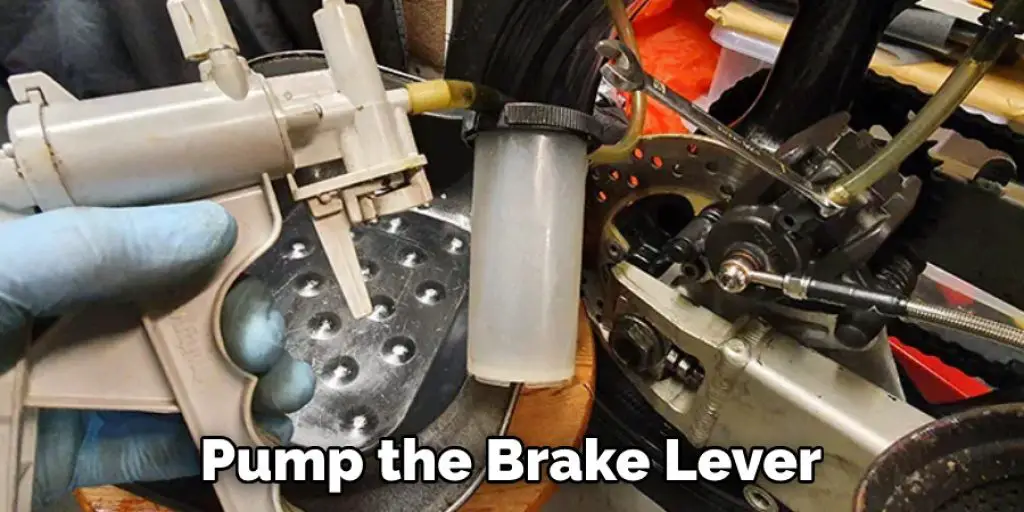
Step 6: Close the Bleed Screw.
Once you have a steady stream of fluid from the syringe with no air bubbles, you can close the bleed screw. Be sure to tighten it firmly so it doesn’t leak. Make sure that, your screw is tight by trying to pull the syringe off the Caliper without loosening the screw.
Step 7: Test the Brakes.
Now that you’ve bled the front brakes, it’s time to test them out. First, pump the brake lever a few times to build up pressure, then try stopping at different speeds. If the brakes feel spongy or unresponsive, you may still have air in the system. In this case, you’ll need to bleed the brakes again.
Step 8: Check for Optimal Brake Performance.
You’re ready to hit the trails if the brakes are working properly. But, check your bike’s manual for specific recommendations on how often to bleed the front brakes. Generally, it’s a good idea to do this maintenance task at least once a year.
Step 9: Reattach the Brake Pads.
Once satisfied with the brake performance, you can reattach the brake pads. But, again, ensure they’re firmly in place, and the retaining screws are tight. You don’t want your pads loose while you’re on the trails.
Step 10: Enjoy Your Ride.
You’re ready to enjoy your ride when your front brakes are bled and working properly. Always ride safely and within your abilities. And if you have any questions about bleeding your front brakes, be sure to consult with a qualified mechanic.
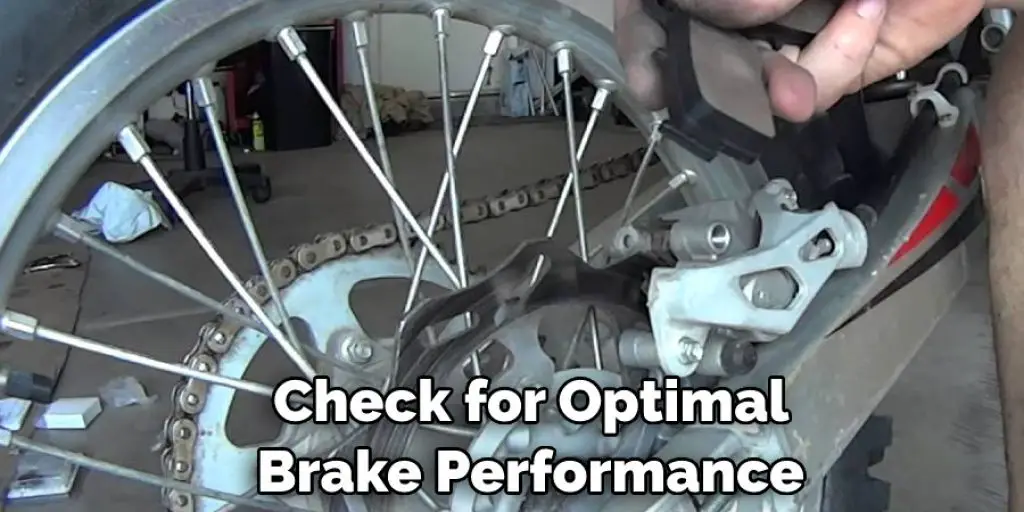
Bleeding the front brakes on your dirt bike is an important part of regular maintenance. By following these simple steps, you can ensure your brakes are always in top condition and ready for the trails.
Some Helpful Tips to Maintain Your Dirtbike Brakes:
Here we have given tips on how to bleed front brakes on dirt bike and maintain it regularly.
- Always keep your pads clean and free of debris.
- Check your brake fluid level regularly and top it off as needed.
- Be sure to bleed your brakes according to the manufacturer’s instructions.
- Inspect your brake hoses and lines periodically for leaks or damage.
- Keep an eye on your brake pads and replace them as necessary.
- If you think the dirt bike brakes are not working as they should, have them checked by a qualified mechanic.
- When making your repairs, always use the proper tools and follow the instructions in the service manual.
- Be extra careful when riding in wet or muddy conditions, as it can be easy to overheat your brakes.
Few Things to Consider Before Bleeding Dirt Bike Brakes:
1. Wear Gloves to Avoid Getting Dirty:
Wear gloves to keep your hands clean while working with brake fluid. Ensure you have a good grip on the syringe or other tools you use to avoid making a mess. If you think the gloves will make it difficult to work, you can always try using a cloth or paper towel to protect your hands.
2. Have a Container for the Brake Fluid:
You’ll need somewhere to put the used brake fluid while bleeding the brakes. An empty, clean container with a lid works well. You can also use an old soda bottle or something similar. Just ensure it’s clean and has a tight seal, so the brake fluid doesn’t leak out.
3. Know Which Line to Bleed First:
The front brakes on a dirt bike are usually bled first. This is because the front brake lever provides most of the stopping power. If you’re unsure which line to bleed first, check the owner’s manual for your specific bike.

4. Have a Funnel and Brake Fluid:
You’ll need to add fresh brake fluid to the reservoir after bleeding the brakes. A funnel makes this process much easier and less messy. Make sure you use the correct type of brake fluid for your bike. Check the owner’s manual or ask a salesperson at the motorcycle shop if you’re unsure.
5. Work on One Caliper at a Time:
It’s best to work on one Caliper at a time when bleeding the brakes. This way, you can be sure that both sides are bled evenly. If you bleed both calipers simultaneously, it’s easy to lose track of which line has been bled and which hasn’t.
6. Be Careful Not to Spill Any Fluid on the Pads:
Brake fluid can damage the brake pads if it spills on them. Be careful not to get any on the pads while bleeding the brakes. If you do, be sure to clean it off immediately. When in doubt, it’s always best to err on caution and use a cloth or paper towel to protect the pads.
7. Have Patience:
It can be tempting to try to bleed the brakes as quickly as possible. However, it’s important to take your time and be patient. If you rush, you may not get all the air out of the lines, which can cause braking problems.
How Do You Gravity Bleed Dirt Bike Brakes?
The easiest way to gravity bleed your brakes is to use a turkey baster or syringe to suck the old fluid out of the reservoir, then squirt new fluid in until it comes out the bleeder valves. You can also use a small funnel if you don’t have a turkey baster or syringe. Put the funnel in the reservoir and pour new fluid into it until it comes out of the bleeder valves.
If you don’t have turkey basters or syringes, you can use a small funnel to gravity bleed your brakes. Simply put the funnel in the reservoir and pour new fluid into it until it comes out of the bleeder valves. Make sure that you don’t get any air bubbles in the fluid, as this will cause your brakes to feel spongy.
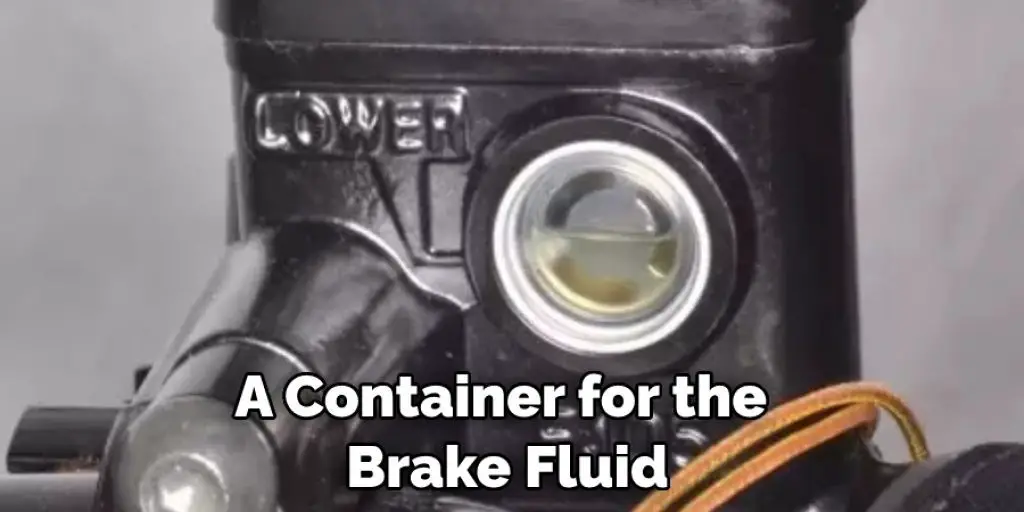
Conclusion
The brake system on a dirt bike is relatively simple, consisting of just two components- the front and rear brakes. The front brake is the most important, as it’s responsible for stopping the bike. The rear brake can help slow down the bike, but it should not be relied on to stop it. This post has shown you how to bleed front brakes on dirt bike. This is a fairly simple process that only takes a few minutes.
If you’re having trouble braking or if your brakes feel soft or spongy, bleeding them may solve the problem. Bleeding the brakes is necessary to ensure your dirt bike stops on a dime. By following these simple steps, you can ensure that your brakes are performing at their best. Have you bled your brake before? What was your experience like? Let us know in the comments below.

